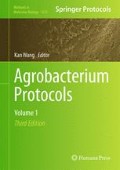Abstract
Genetic modification of plants by the insertion of transgenes can be a powerful experimental approach to answer basic questions about gene product function. This technology can also be used to make improved crop varieties for use in the field. To apply this powerful tool to red clover, an important forage legume, a population of red clover with high potential for regeneration in tissue culture has been developed. Here we provide a detailed procedure for Agrobacterium-mediated transformation of genotypes derived from this regenerable population. We have successfully used this methodology to express β-glucuronidase (GUS) reporter genes as well as for hairpin RNA-mediated silencing of endogenous genes for polyphenol oxidase and a transferase crucial in phaselic acid accumulation.
Access this chapter
Tax calculation will be finalised at checkout
Purchases are for personal use only
References
Jefferson RA, Kavanagh TA, Bevan MW (1987) GUS fusions-β-glucuronidase as a sensitive and versatile gene fusion marker in higher-plants. EMBO J 6:3901–3907
Sullivan ML, Hatfield RD, Thoma SL et al (2004) Cloning and characterization of red clover polyphenol oxidase cDNAs and expression of active protein in Escherichia coli and transgenic alfalfa. Plant Physiol 136:3234–3244
Quesenberry KH, Wofford DS, Smith RL et al (1996) Production of red clover transgenic for neomycin phosphotransferase II using Agrobacterium. Crop Sci 36:1045–1048
Wofford DS, Baltensperger DD, Quesenberry KH (1992) In vitro culture responses of alyceclover genotypes on 4 media systems. Crop Sci 32:261–265
Wan Y, Sorensen EL, Liang GH (1988) Genetic-control of in vitro regeneration in alfalfa (Medicago sativa L.). Euphytica 39:3–9
Quesenberry KH, Smith RR (1993) Recurrent selection for plant regeneration from red clover tissue culture. Crop Sci 33:585–589
Smith RR, Quesenberry KH (1995) Registration of NewRC red clover germplasm. Crop Sci 35:295
Sullivan ML, Hatfield RD (2006) Polyphenol oxidase and o-diphenols inhibit postharvest proteolysis in red clover and alfalfa. Crop Sci 46:662–670
Sullivan ML, Zarnowski R (2011) Red clover HCT2, a hydroxycinnamoyl-coenzyme A:malate hydroxycinnamoyl transferase, plays a crucial role in biosynthesis of phaselic acid and other hydroxycinnamoyl-malate esters in vivo. Plant Physiol 155:1060–1067
Lee MRF, Tweed JKS, Cookson A et al (2010) Immunogold labelling to localize polyphenol oxidase (PPO) during wilting of red clover leaf tissue and the effect of removing cellular matrices on PPO protection of glycerol-based lipid in the rumen. J Sci Food Agric 90:503–510
Gleave AP (1992) A versatile binary vector system with a t-DNA organizational structure conducive to efficient integration of cloned DNA into the plant genome. Plant Mol Biol 20:1203–1207
Rogers SG, Klee HJ, Horsch RB et al (1987) Improved vectors for plant transformation-expression cassette vectors and new selectable markers. Method Enzymol 153:253–277
Becker D (1990) Binary vectors which allow the exchange of plant selectable markers and reporter genes. Nucleic Acids Res 18:203
Hellens R, Mullineaux P, Klee H (2000) A guide to Agrobacterium binary Ti vectors. Trends Plant Sci 5:446–451
Gamborg OL, Miller RA, Ojima K (1968) Nutrient requirement of suspension cultures of soybean root cells. Exp Cell Res 50:151–158
Moore GA, Jacono CC, Neidigh JL et al (1992) Agrobacterium-mediated transformation of citrus stem segments and regeneration of transgenic plants. Plant Cell Rep 11:238–242
Wise AA, Liu Z, Binns AN (2006) Three methods for the introduction of foreign DNA into Agrobacterium. In: Wang K (ed) Agrobacterium protocols, vol 1, 2nd edn. Humana Press, Totowa, NJ, pp 43–54
Rogers SG, Horsch RB, Fraley RT (1986) Gene transfer in plants-production of transformed plants using Ti-plasmid vectors. Method Enzymol 118:627–640
Wise AA, Liu Z, Binns AN (2006) Nucleic acid extraction from Agrobacterium strains. In: Wang K (ed) Agrobacterium protocols, vol 1, 2nd edn. Humana Press, Totowa, NJ, pp 67–76
Taylor NL (1980) Clovers. In: Fehr WR, Hadley HH (eds) Hybridization of crop plants. American Society of Agronomy and Crop Science Society of America, Madison, WI, pp 261–272
Adair D, Irwin R, Traynor PL (2001) A practical guide to containment. Information Systems for Biotechnology, Blacksburg, VA
Acknowledgements
We wish to thank Heather Green for helpful comments on the manuscript, Sara Zerbel and Lisa Koch for excellent technical assistance, and Dave Rancour for photographic assistance.
Author information
Authors and Affiliations
Corresponding author
Editor information
Editors and Affiliations
Rights and permissions
Copyright information
© 2015 Springer Science+Business Media New York
About this protocol
Cite this protocol
Sullivan, M.L., Quesenberry, K.H. (2015). Clover, Red (Trifolium pratense). In: Wang, K. (eds) Agrobacterium Protocols. Methods in Molecular Biology, vol 1223. Springer, New York, NY. https://doi.org/10.1007/978-1-4939-1695-5_19
Download citation
DOI: https://doi.org/10.1007/978-1-4939-1695-5_19
Published:
Publisher Name: Springer, New York, NY
Print ISBN: 978-1-4939-1694-8
Online ISBN: 978-1-4939-1695-5
eBook Packages: Springer Protocols

